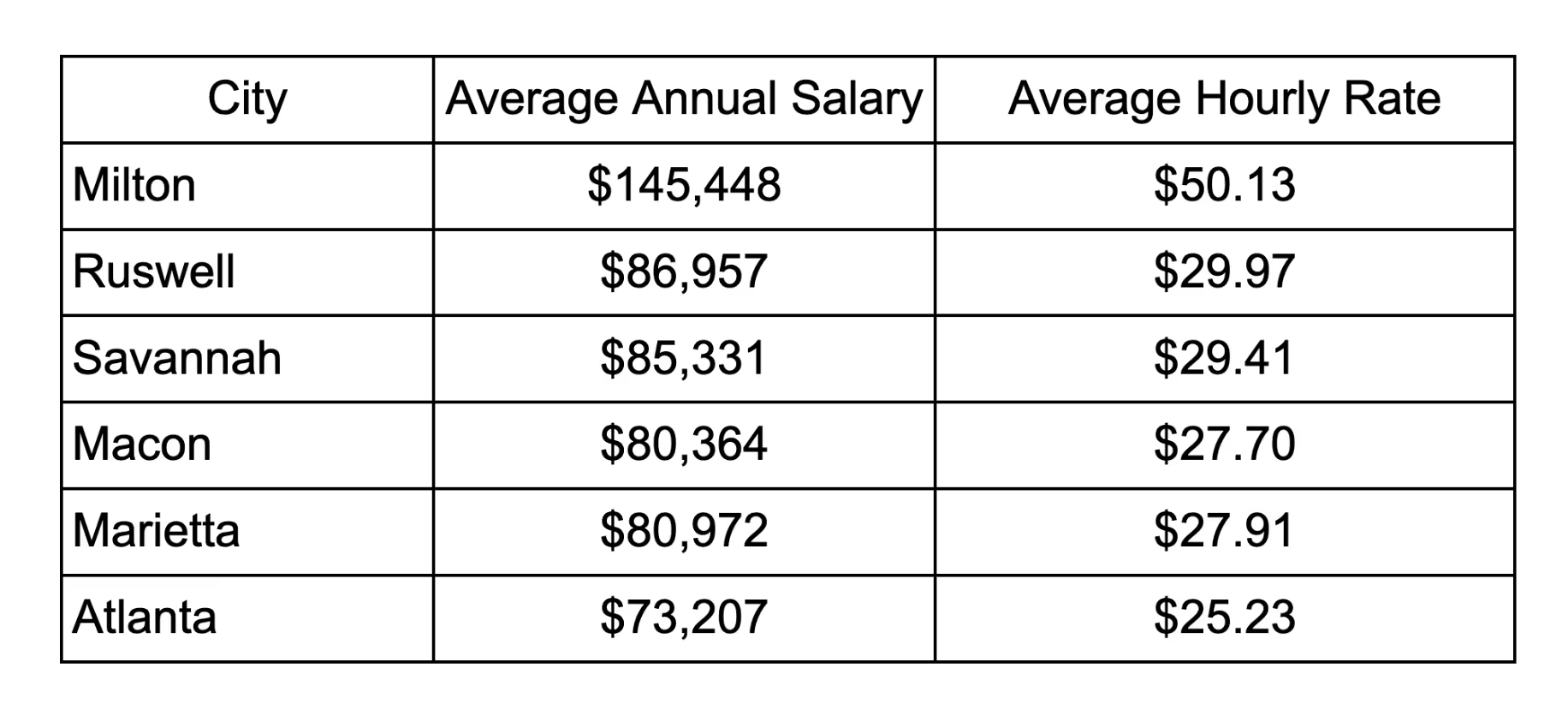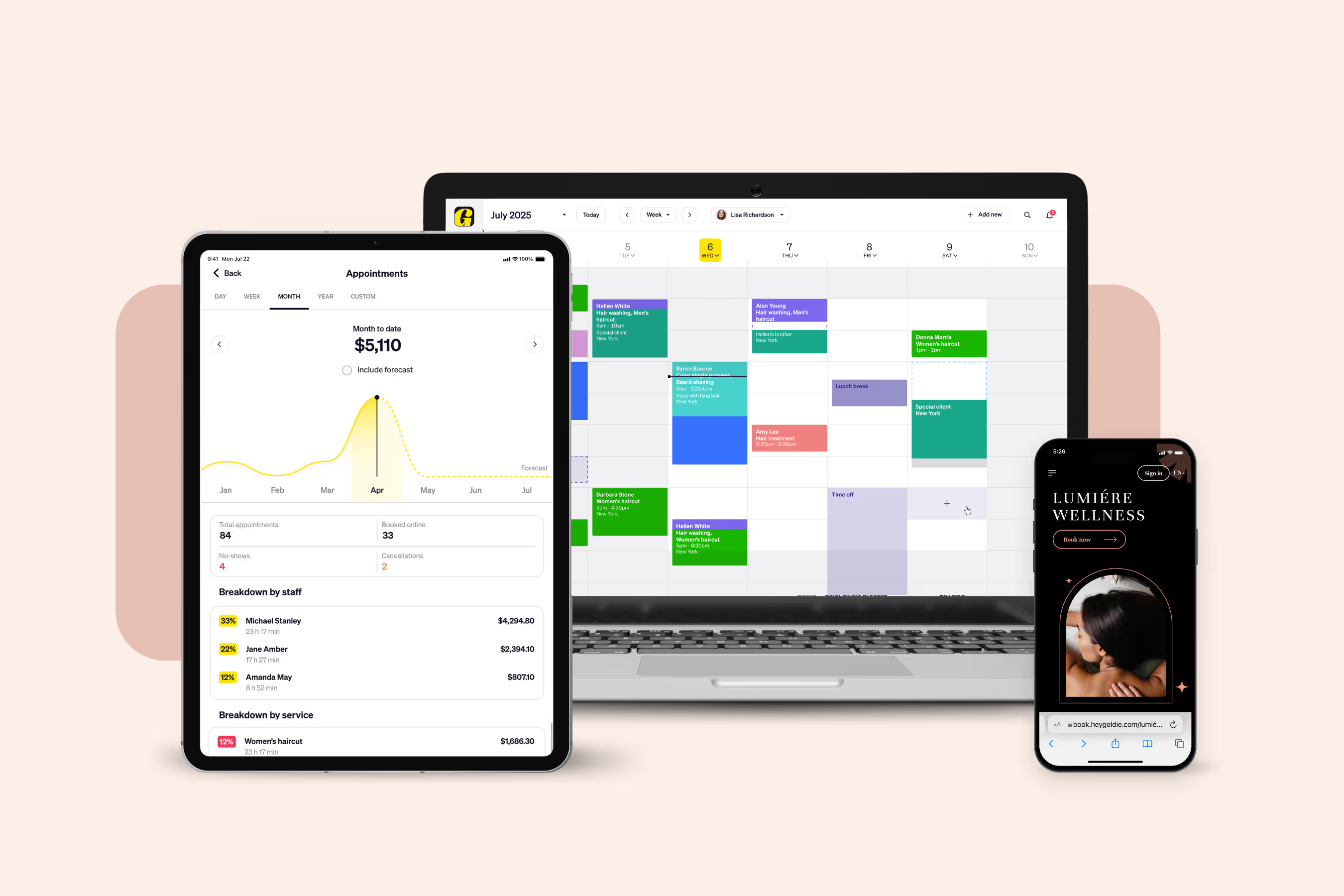
Having a career in hairstyling offers flexibility, creativity, and the potential for great earnings. If you’re considering starting a career as a hairstylist in Georgia, it’s important to understand how the Peach State measures up when it comes to pay and opportunities. In 2025, Georgia’s hair care market generated $39.67 million in revenue, with an expected annual growth rate of 3.6% through 2030.
The state is home to thousands of hairdressers, hair stylists, and cosmetologists, with employment expected to grow steadily with employment projected to grow from 11,930 in 2022 to around 13% higher by 2032. The Bureau of Labor Statistics also estimates 1,860 annual job openings in Georgia by 2026, reflecting consistent demand for skilled professionals.
From high-end salons in Buford to bustling studios in Atlanta, here’s a look at what hairstylists are actually earning throughout Georgia and how that compares to national norms.
According to job postings on Indeed from the past 36 months, hairstylists in Georgia earn between $12.39 and $65.84 per hour, with the average coming in at $28.56 per hour. This means an annual salary of around $82,849.
When compared to the national average of $70,913, Georgia hairstylists are doing well earning about 17% more than their colleagues across the country. While not the highest-paying state (Delaware leads with earnings around 28% above the national average), Georgia still offers strong earning potential and plenty of opportunities for hairstylists looking to grow their careers.
Georgia also benefits from a relatively affordable cost of living. For example, the average rent for a one-bedroom apartment in Georgia is around $1,150 per month, utilities and groceries are slightly below the national average, and transportation costs are moderate. Therefore, hairstylists can enjoy great earnings while having a comfortable lifestyle without the high expenses found in some other states.

When looking at hairstylist wages across Georgia’s major cities, the numbers might surprise you. According to Indeed, Milton tops the list, with an average hourly rate of $50.13. For a city with a population of fewer than 41,000 residents, that translates to an annual salary of around $145,448.
What’s unexpected, however, is that Atlanta, the state’s capital and largest city, only matches the national average rate. Typically, you’d expect salaries in major metropolitan areas to outpace smaller cities, but Georgia’s data shows that isn’t always the case.

While larger cities often see more competition between hairstylists, smaller towns in Georgia can tell a different story. With fewer salons and less saturation, stylists in these areas often have the ability to charge higher prices for their services.
In fact, some rural parts of Georgia report wages that rival, or even exceed, those in urban markets. Take Buford, for example. Despite having a population of fewer than 20,000 residents, hairstylist salaries here remain highly competitive with those in larger cities, showing that small-towns can offer big earnings.

Just like in other beauty-related professions, there are several factors that influence how much a hairstylist can earn.
The number one factor is the experience level. Entry-level stylists often begin with lower hourly rates, while seasoned professionals with loyal clients and advanced skills can ask for higher pays. This progression of higher earnings as expertise grows is a common career path no matter the industry.
Another key factor influencing a stylist’s income is the type of employment they choose. Many begin their careers in salon settings, where they can gain experience, build a loyal client base, and benefit from the stability of regular hours. While salon positions offer dependable pay, they often don’t match the earning potential of more specialized or independent paths.
Those who prefer flexibility often explore freelance or mobile hairdressing. Stylists in high-income areas can set their own rates and travel directly to clients, often increasing their income. The trade-off, however, is that they must manage their own business expenses, scheduling, and client acquisition.
For stylists, specialized fields can open the door to higher earnings. Services like advanced color work, extensions, and barbering are in high demand, often commanding premium rates due to the skill and training required. Bridal hairdressing is another consistently profitable niche, as weddings are occasions where clients are willing to invest in exceptional styling. Freelancers usually choose to combine these opportunities, working on bridal parties one day, focusing on color or extensions the next, and even taking on barbering clients or fashion projects later in the week. This diversity can increase income and help you create a rewarding career path.
In Georgia, as in much of the U.S., gratuities are a major part of a stylist’s take-home pay. While the standard tip for salon services typically 20%, many clients tip more generously if they ask for high-end treatments. For stylists, this means that two professionals with the same hourly rate can end up with very different incomes depending on their client base and location.
Earnings are also shaped by the payment structure a stylist works under. In some salons, pay is based on an hourly wage, which offers stability but usually caps income potential. Others operate on a commission system, where stylists earn a percentage of each service, somewhere between 40% and 60%, allowing high performers to make more. A third common model is booth rental, where stylists rent a chair or space in a salon and set their own prices. While this gives independence and income control, it also means covering expenses such as rent, supplies, insurance, and marketing.

If you’re aiming to go beyond your standard earnings, it takes more than just showing up for scheduled appointments. From sharpening your skills and specializing in high-demand services to building a social media brand, there are plenty of ways to grow your income, but in this article we’ll mention three tips.
Pre-booking is one of the most effective ways for hairstylists to increase their income. You may be hesitant to suggest it when starting out, feeling like it might be unnecessary or pushy. But once you begin offering the option, you will be surprised by how many clients are willing to commit to their next appointment.
When clients are pre-booked, it essentially guarantees future income. Just like offering an add-on treatment, the principle is simple: if clients are given the option, some will say yes. But if they’re never asked, the answer will always be no. A professional way to approach this is by guiding clients during checkout. You can say you recommend them to come back in about six to eight weeks for a mini highlight or gloss to keep everything looking fresh and ask if they want to schedule the appointment now. Offering a clear recommendation makes it easy for clients to say yes and that’s how you’ll build a strong clientele.
With or without a receptionist, a tool like Goldie is a must. Goldie allows hairstylists to quickly book the client’s next appointment on the spot, send automatic reminders, and even suggest the ideal time frame for their next visit. By integrating pre-booking into the checkout process with Goldie, you can keep your schedules full, and provide a seamless experience for their clients.

One of the quickest and easiest ways to increase your income as a hairstylist is by offering add-on services to the clients already in your chair. They’re planning to spend money anyway, so it’s the perfect time to recommend something that truly benefits them. For example, suggesting a deep conditioning treatment, since most clients usually complain about their hair feeling dry.
Hair dressers can be nervous about sounding salesy, but the key is not to be pushy. You can bring it up casually during the shampoo, saying something like, “Do you want to do a deep conditioning treatment today?”. Half the time, clients will say yes right away without asking further questions. If they do ask, offer explanations about what it is, why you mentioned it, and how much it costs. The beauty of this approach is that you’re simply giving your clients an option. Many will say yes if you ask, but if you don’t offer, they’ll never even have the chance.

Another reliable way for hairstylists to boost their income is through product sales. Every salon sets up commissions differently; it can be 10% or even higher. Clients who spend hundreds of dollars on their color deserve recommendations for products that will help protect and maintain it. One of the most effective strategies is to leave three of the products used during the service, such as a shampoo, conditioner, and leave-in treatment at the front desk during checkout. Even if clients don’t purchase all three, the chances that they’ll take home at least one product. Or if you are not comfortable selling at the salon, you can use Goldie. You can sell products directly through the app and create reports to track what’s a hot buy helping you know when it’s time to restock. If you reframe your product sales as client support rather than pressure and recommend what your clients need, you can easily grow your income.
With an average annual salary of $82,849, Georgia offers hairstylists great earning potential. Still, as we’ve seen, earnings can vary widely depending on factors like location, experience, and specialization. At the end of the day, how much you make often depends on the effort you put into building your skills, growing your client base, and seizing new opportunities.
